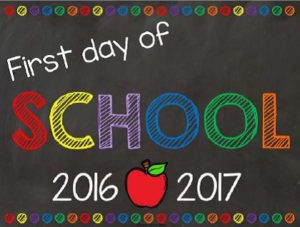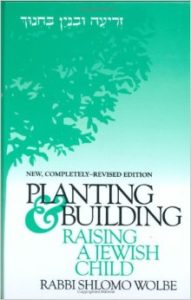Welcome Back To Old School
When it comes to parenting, there is no manual. Back in the day, my mom kept Dr. Spock’s Baby and Child Care paperback in her nightstand, next to the S&H Green Stamps and the TV remote. I never noticed any dog-eared corners on the faded brown pages so doubt if she ever referred to this “timeless bestseller.†Turns out she probably could have used some expert advice on how to redirect her high-spirited daughter because her idea of discipline was chasing me down the hallway with a flyswatter.
Most of us are clueless when it comes to raising children, which explains why today’s generation of moms can’t get enough of The Happiest Baby (Toddler) on the Block, and How to Talk So Kids Will Listen, and Positive Discipline, and NurtureShock, and Einstein Never Used Flashcards, and Parenting Without Power Struggles, and Face to Face: Cultivating Kids’ Social Lives in Today’s Digital World†and so on.
And that’s before our kids reach kindergarten!
My personal favorites from a Jewish perspective are Wendy Mogel’s Blessings of A Skinned Knee and Blessings of a B Minus,†which I discovered around the time my son Jack was preparing for his bar mitzvah and my daughter Sari was pushing my buttons in second grade. Now they are ages 21 and 17, respectively, and so far they have survived childhood, puberty, adolescence, and are progressing towards adulthood with the inevitable bumps in the road.
As parents, we never stop learning. We do our best. The sooner we realize that imperfect parenting is not only acceptable, but also preferable, the better off we and our kids are.
So, now that the back-to-school season is well underway, I feel like I need a refresher course on the real purpose of education. Of course, Judaism offers much insight on that topic, as well as everything else you need to know about raising children to become self-reliant adults. I guess parenting does come with a manual after all. It’s called the Torah, and the ancient words of wisdom are as relevant today as when the Jews were wandering the desert.
For example, in the Proverbs, King Solomon says: “Educate the child according to his way so that he will not turn from it when he is old.”
What does this mean? To me, it means that it’s our job as parents to understand the strengths and weaknesses of each of our individual children and allow them to become the best person he or she can be. It’s our holy obligation as parents to help our children discover their unique talents, personality, and skills and not mold them into someone we think they should be.
A Hasidic teaching says, “If your child has a talent to be a baker, don’t tell him to be a doctor.â€
So on Shabbat, when we put our hand on our child’s head and say the blessing, we are not actually expecting our daughter or son to reach the holiness of the matriarch Sarah or the patriarch Ephraim, because that is unattainable, but our prayer is for them to aspire to live up to their own highest potential.
With the overemphasis of standardized testing, and more memorizing than learning, the modern school system has a long way to go. However, differentiated instruction at least recognizes what Judaism has known all along. Students learn in different ways.
For example, some students are more social and thrive on group activities, while others learn better one-on-one, or independently. Some students are auditory learners and prefer to listen to lectures and participate in classroom discussions. Visual learners benefit from a variety of ocular stimulation, such as the use of colors, images and written information in a textbook to increase their understanding. Another more common learning style is tactile, in which people learn best by doing hands-on activities, real problem solving, and experimenting.
As parents and teachers, we fail our children when we don’t understand and respect how they learn best. In fact, studies show that only 30 percent of students in the classroom understand the lesson; 30 percent don’t get it at all and therefore misbehave; and 30 percent pretend to understand the material but don’t connect with the teacher. The other 10 percent, what, are they hanging out in the bathroom or playing hooky from school?
“A lecture is not education. When you memorize something, like the Torah, you are not really learning it. You can spit it back, but it’s short term. You have to really get in there, get your hands dirty, and immerse yourself in what you’re learning,†says Rebbetzin Mimi David, Director of Women’s Education at Aish HaTorah St. Louis. “Being a parent is the hardest job in the world. If we don’t get it right, we can break their spirit.â€
Mimi would know, she’s a mom of seven children, age three to 20, including three of them who are spread out in schools in Baltimore, Israel, and Minneapolis.
“Hashem wants each of us to the best ‘me’ we can be. As parents we help our kids work on their character, their imperfections and don’t force them to play sports when they would rather play piano. It’s a mitzvah to teach them according to their ways and understand our child,†says Mimi, who teaches a Coffee Schmooze every other Thursday morning as part of the ongoing classes, programs, and activities offered by the Jewish Women’s Society (JWS) in St. Louis. JWS is open to moms (and non-moms) of all backgrounds who want to enrich their lives by implanting Jewish values.
One of the most simple yet profound analogies Mimi shares with us comes from the educational philosophy of the late Rabbi Shlomo Wolbe, author of Planting and Building in Education. This book explains how the educator needs to “build†the students on the firm ground of Torah and yet at the same time allow the students to “grow,†each in their own personal and individual way.
So, while we drink our pumpkin latte at Starbucks, Mimi explains that the parent is like a fence that provides boundaries, and the child is like a grape vine that grows along the trellis.
“The child (vine) grows sideways along the fence and then turns around at the end and comes back, like a cycle. The support of the fence (parent) guides the vine the way it’s going to grow. As parents, we plant ideas, understanding, and guidance in our child’s mind,†she says.
For example, let’s say I am driving in my car with my daughter (of course she’s switching the radio station), and I see a person stopped at a red light next to us who is texting. This is a spontaneous teachable moment, while I am calmly sitting in my car with my teenager trapped inside who can’t escape until we get to the mall. This is a good time to plant a seed about distracted driving and how this other person is being irresponsible by risking an innocent person’s life. Hopefully, my daughter will think twice before she answers her cell phone while she’s driving.
“Like a vine that grows, we provide the framework. Planting needs the right amount of sun, warmth, water in order to grow.â€
The idea of “building†is more structured like a foundation, planned out, a blueprint that you have created. The example Mimi uses, what if her daughter comes home an hour after curfew?  The next night she is expected to be home an hour earlier than her original time, allowing the consequence to teach her how to be more responsible next time. Boom!
“Building is not the time for a lecture. It’s time for action, and can be both good or bad,†says Mimi. “We must use the right tool at the right time. They need to learn on their own, build character, which takes a lot longer but the consequences are greater.  We build them up so that if they mess up they don’t fall apart.â€
Bottom line, we have a lot to learn when it comes to teaching our kids. Now it’s time to hit the books!


